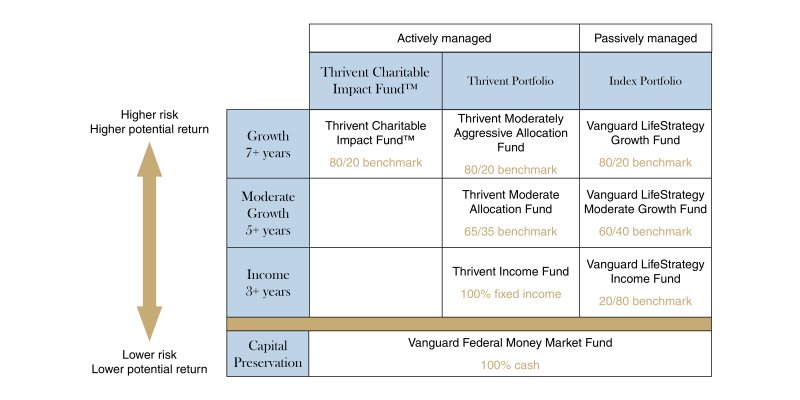Why understanding your risk tolerance can lead to smarter investments
When we hear the word risk, skydiving, public speaking and standing up to your boss may come to mind. But where does risk fit into your finances?
All financial decisions come with a certain degree of risk. Fortunately, there's a positive correlation between risk and returns. Understanding those risks can help you plan for them and make smarter investment decisions overall.

The types of risk in investing
In finance, risk refers to how much potential loss (risk) is associated with an investment (reward). The most common types of risks in savings and investing include:
- Market risk - your investments could lose value due to market ups and downs (volatility).
- Longevity risk - the potential of outliving your savings.
- Inflation risk - involves losing purchasing power because your investments aren't growing because they aren't keeping up with inflation.
- Liquidity risk - not being able to sell your investments when needed.
- Horizon risk - your investment horizon – or how long you plan to hold an investment – shortens due to an unforeseen event.
- Concentration risk - losing money because it's tied up in one investment or one type of investment.
- Reinvestment risk - losing money after reinvesting at a lower interest rate.
- Credit risk - loss in bond value because its issuer ran into financial difficulties.
- Foreign investment risk - complexities of investing abroad could compromise gains.
How risk profiles vary: High to low risk tolerance
If you're focusing on capital appreciation, you’ll likely be a more aggressive investor than someone who is working toward a healthy nest egg over the next 10 to 15 years. But how long should you stick with an aggressive strategy? The short answer is that as your goals and priorities change, your strategies will follow suit. And how your strategies adapt is up to you. You may find as you enter a new life stage, you're looking for safer investments.
Natalie Kratzer, a Thrivent financial advisor, explains "Investing with purpose means understanding the true goal of the money that we're putting away. It also means not taking more risk than what you're comfortable having within your portfolio."
Typically, the average investor will start out with an aggressive or even moderate approach and shift to a more conservative strategy as they get older. But that might not always be the case; with routine attention to your investments, you can create a strategy focused on safer investments with a history of higher returns and potentially gain more without taking on more risk. One flexible option you could consider is target risk funds, which as the name suggests, targets a specific risk tolerance. With target risk funds, you can reduce or increase the risk as your circumstances change.
Factors that impact your risk tolerance
There are several factors that impact your risk tolerance, including your age, assets and even past experiences that have influenced your perspective.
Age (or life stage)
Younger people have a higher risk tolerance when investing since they naturally have a longer time horizon. When your time horizon is longer, you can take on more risk because your investments have more time to balance out through market fluctuation. In an interview about risk and risk tolerance, Thrivent financial advisor Dan Demers recalls a conversation with his client about this exact concern.
"I asked … how [my client] was feeling during the bottom of a stock market downturn, and she said, 'Dan, right now I feel okay, but if I was five years older and this happened again, I would probably be a little bit scared.'" Dan noted this comment in the client's file so they could reconsider her risk tolerance and whether to transition into slightly lower risk funds in preparation for the future.
Your investment knowledge & experience
How familiar are you with investing? If you're just starting out, it's smart to err on the side of caution, even if that means opting for a more moderate approach. However, if you lack personal experience, learning from financial mentors and working with a financial advisor to assess your finances and charitable goals can fill in your knowledge gaps so you can increase your risk tolerance confidently and invest money wisely while minding other personal risk factors.
Your charitable goals
Are you planning to grow your fund over your lifetime and beyond? Do you want to give out funds to your favorite charities each year? Your charitable goals, and the time frame you set to achieve those goals, will certainly influence your risk tolerance.
You can enjoy more success with your investments when you work with a financial advisor or Thrivent Charitable to clarify the specificity of your goals and adapt your plan as those details change. Natalie Kratzer notes that "Investing with purpose means … having a short-, mid-, and long-term objective for the money and understanding at what point … do we need to pivot or adjust … that allocation or the whole plan."
Your income
Income, your current net worth, and risk capital—or the money you can safely invest without impacting your current lifestyle—are all important factors when defining your risk tolerance. Those who have more disposable income or a higher net worth can withstand more risk. But that doesn't mean those with lower income are limited to low-return investments. Some investments, like bonds have less risk than stocks but still post good returns by providing steady income distributions.
Market conditions
Market conditions can influence your decision to be more aggressive with your investment or pull back into a more conservative approach. It is recommended not to let emotions guide these decisions, and to instead reflect on past market declines and assess the facts.
With the right guidance, you can make smarter investment decisions
When you work with a Thrivent financial advisor and Thrivent Charitable, you can clarify your own risk factors and how they make up the bigger picture of your risk tolerance, specifically for your charitable investments.
The chart below summarizes the risk for each of the Thrivent Charitable investment offerings. Use it or

While diversification can help reduce market risk, it does not eliminate it. Diversification does not ensure a profit or protect against loss in a declining market. Investing involves risks, including the possible loss of principal.
Performance results will include Thrivent Charitable administrative fees and may differ from the results of the underlying fund.
